What You Should Know
What You Will Learn
- Alternate picking technique
- Picking patterns for various rhythms
- Basic exercises for alternate picking
How to Alternate Pick
What is Alternate Picking?
Alternate picking is an efficient approach for playing single notes on the guitar. It involves using an alternating succession of upstrokes and downstrokes. Many beginning players tend to use only downstrokes. This is inefficient, due to the necessity of an upward motion to return to a position above the string in preparation for the next downstroke. Using this upward motion to pick the next note is far more efficient. If you currently use only downstrokes, your playing will improve drastically if you learn alternate picking.
Review
The following symbols are used for upstrokes and downstrokes:
 - downstroke
- downstroke - upstroke
- upstroke
Alternate Picking Technique
Type of Pick
The type of pick you use will affect how easy it is to alternate pick. A thicker pick is generally better because it has less flexibility. It is possible to alternate pick with a thinner pick, but if the pick is too flexible, it may limit your speed.
Holding the Pick
The pick should be held firmly enough to prevent it from moving back and forth as you pick, but not so firm that you are tense. A pick that has ridges on it may help you keep your grip on the pick.
Angle of the Pick
The pick should be held at roughly a 45° angle to the strings. This may be challenging at first if you are used to holding the pick parallel to the strings.
Use the Tip
Only the very tip of the pick should be used. This minimizes the resistance of the string when picking each note since only a very small portion of the pick comes into contact with the string. This allows for much faster playing.
Alternate Picking Technique
Shape of the Hand
The proper shape for the right hand can be achieved by relaxing your right arm by your side. Your hand should assume a natural, relaxed position that works well for alternate picking.
Motion of the Hand
The motion for alternate picking should come primarily from the wrist. Your movements need to be as small as possible. The pick should travel only far enough past the string to allow it to vibrate without the pick getting in the way while also preparing for a stroke in the opposite direction. It will take practice to make this motion as economical as possible, so don't worry too much if your picking motion is a little wide at first.
Upstrokes
Try to make your upstrokes as smooth and controlled as your downstrokes. Upstrokes tend to feel awkward at first, so pay close attention to make sure you are playing them properly.
Moving from String to String
Movement of the arm at the elbow can be used to help move the pick to different strings, but shouldn't be used for the picking motion. This movement should be very slight. You don't need to move the elbow very much even when going between the first and sixth strings.
Things to Avoid
Anchoring
Many players anchor their hand by placing the pinky on the body of the guitar next to the high E string or by resting their palm on the strings. While some very good players do this when playing, they play well despite using this approach, not because of it. Anchoring restricts your movement and may cause tension.
Sticking the Pinky Out
Some players stick out the pinky so that it is extended out from the other fingers. This may cause unnecessary tension in the hand. You can feel this by keeping your fingers curved, almost like you are holding a ball, then extending the pinky out. Do you feel a difference in the tension in your hand and fingers?
Tips
Both Hands are Important
Pay as much attention to the right hand as your left hand. Many players tend to watch the left hand while ignoring the right hand. This will lead to uneven development of the hands, so watch both while you play. One easy way to do this is to practice a passage while watching one hand and then repeating the passage while watching the other.
Use a Metronome
Practice the exercises with a metronome. Gradually increase the speed of the metronome as you become comfortable with each pattern and exercise. Set the tempo as slow as necessary to play each exercise cleanly.
Stay Relaxed
Keep your wrist relaxed. It has a tendency to become tense if you play for an extended period of time, so be aware of excess tension as you play. Be aware of tension in other parts of your body too.
Rhythmic Picking Patterns
Alternate picking is easier to learn if you understand when it is appropriate to use an upstroke or downstroke. Most common rhythms, such as eighth and sixteenth notes, have a specific pattern of upstrokes and downstrokes associated with them. Knowing these patterns will allow you to alternate pick almost any passage with ease. Note that these patterns aren't set in stone. While the patterns will work for most situations, they are just guidelines. You may need to use other patterns for certain music.
The picking patterns below show how to play the most common rhythms with alternate picking. Each pattern is shown only on the first string, but you should try playing them on all strings.
Eighth Notes
Eighth notes are played with a downstroke on the beat and an upstroke on the "and" of the beat.
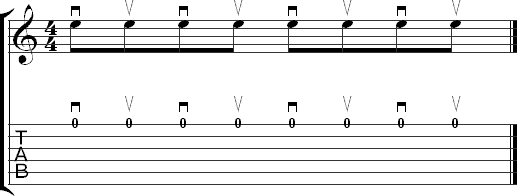
Sixteenth Notes
Sixteenth notes are played with downstrokes on the first and third sixteenth notes and with upstrokes on the second and fourth notes.
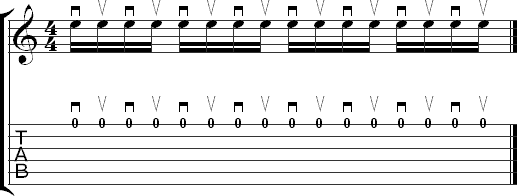
Eighth Note Triplets
Eighth note triplets should be played with a downstroke at the start of one beat and an upstroke on the start of the next beat.
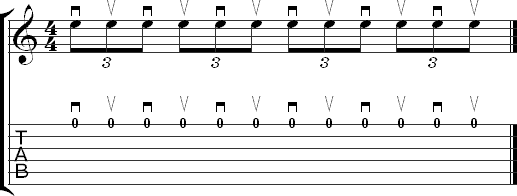
Other Common Rhythms
Gallop
The gallop is an eighth note followed by two sixteenth notes. It is played with two downstrokes followed by an upstroke. It is also possible to alternate between downstrokes and upstrokes on every note, but this may make the picking pattern come out uneven in some situations. Use your judgment to determine which approach to use.
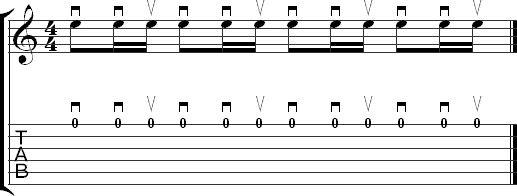
Reverse Gallop
The reverse gallop is the opposite of a gallop: two sixteenths followed by an eighth note.
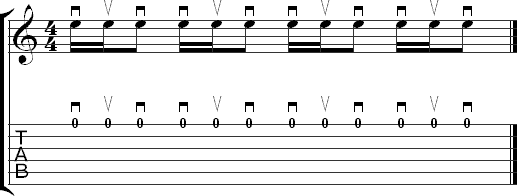
Passages that Start in the Middle of a Beat
If a passage doesn't start on the beat, you should generally start by picking up or down as you normally would for that part of the beat. For example, the example below starts on the second sixteenth note of the beat. This sixteenth note is usually played with an upstroke, so use an upstroke to start this passage. This will make the picking pattern come out evenly so that a downstroke is used for the first sixteenth note on each beat.
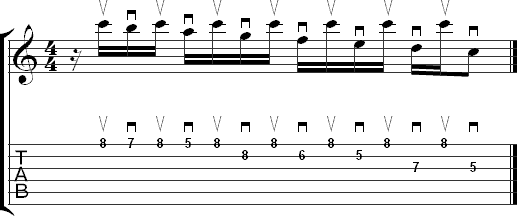
The picking pattern won't always come out symmetrically for every alternate-picked passage. A combination of rhythmic values may create situations where you have to choose between having more than one upstroke or downstroke in a row, or using a nonstandard picking pattern. Which you use will depend on the situation and your preferences..
Odd vs. Even Numbered Subdivisions
The picking patterns for even and odd numbered subdivisions of the beat are consistent in terms of what kind of stroke is used on first note of the beat. Even numbered subdivisions, including eighth and sixteenth notes, will start with a downstroke at the beginning of each beat. Odd-numbered subdivisions will alternate between downstrokes and upstrokes on the start of each beat. This includes triplets, quintuplets, septuplets, and any other odd numbered tuplet.
Alternate Picking Exercises
Exercise 1
Exercise 1 is a simple alternate picking exercise on the open high E string. Focus on minimizing the amount of motion you use to play each stroke. Use these simple open string exercises as an opportunity to perfect your right hand technique. This will make it easier to add the left hand later.
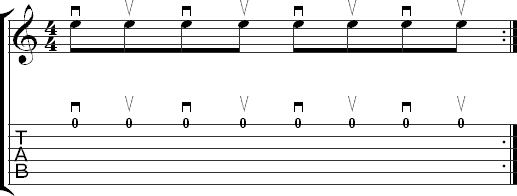
Exercise 2
Exercise 2 requires you to switch between different strings. Play very slowly and concentrate on making all of the notes equal in volume. This can be difficult to do when switching to another string, so pay very close attention to the movement from one string to another. Make sure that every motion is carefully controlled to avoid accidentally playing any note louder than another.
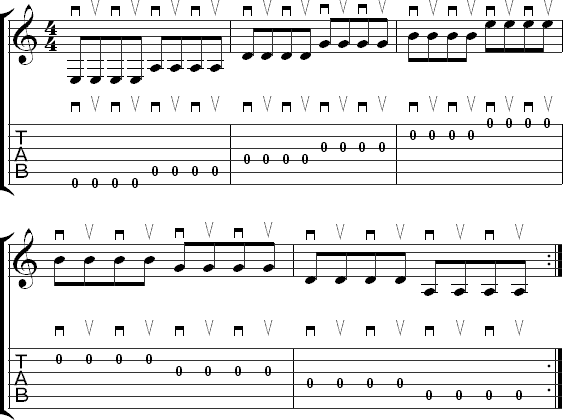
Exercise 3
Exercises 3 is a string switching exercise. This is a good opportunity to focus on getting the technique of switching between strings smoother and more efficient. Watch the pick to make sure it is only going far enough past each string to get in position to play the next stroke. If your movements are too wide, your picking will be slow and inefficient.
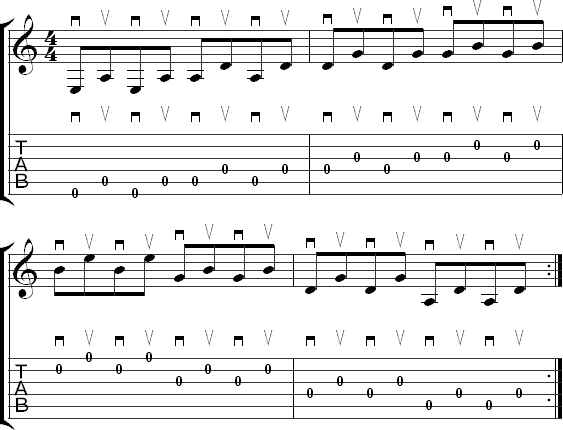
Exercise 4
Exercise 4 is another exercise where the focus is on switching between strings. This time the exercise starts on a higher string and alternates with a lower string.
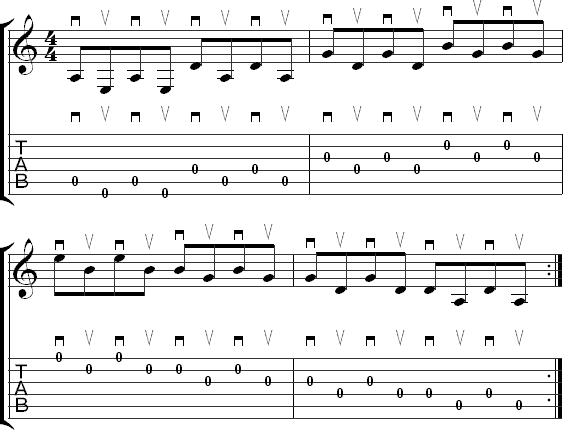
Exercise 5
Exercise 5 is a common alternate picking exercise that involves playing four notes per string with one finger per note. This is the first exercise where you have to use the left hand. Start very slowly, making sure that your hands are coordinated.
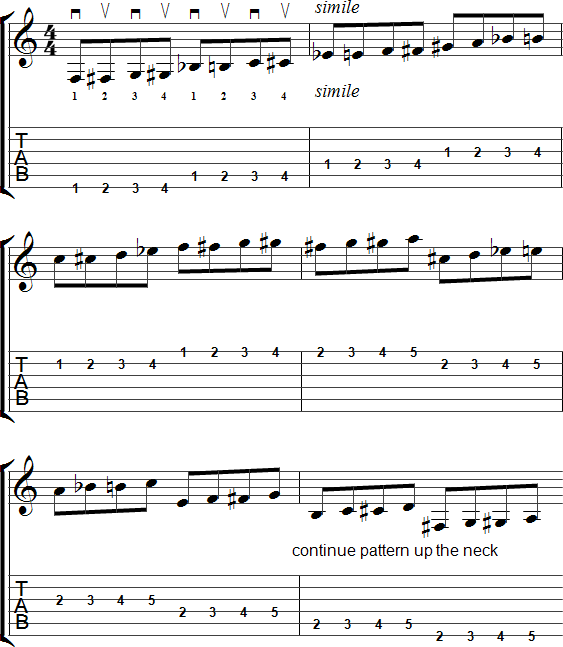
This pattern can be played up and down the entire neck. However, you should only play within the range of a few frets at first. This will allow you to gradually build endurance. Once you are able to comfortably play the exercise up a few frets from your starting fret, start extending the exercise up by one or more frets until you are able to play it up and down the entire neck. Depending on your current level, it may take months or years to reach that point, so be patient.
